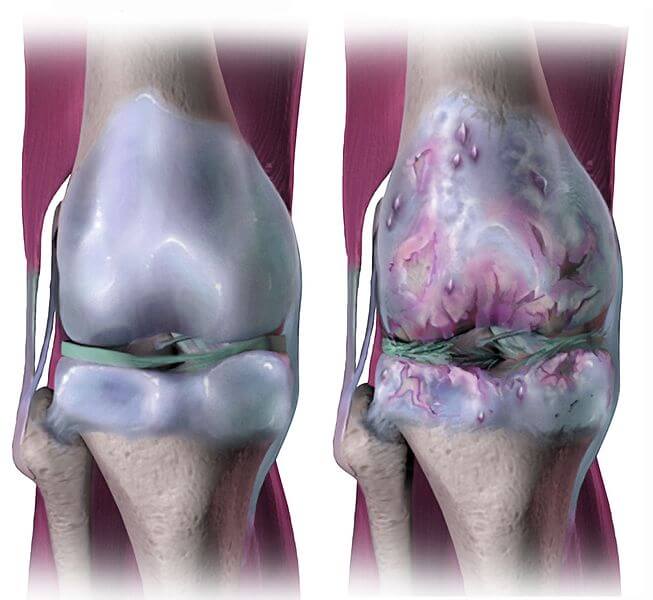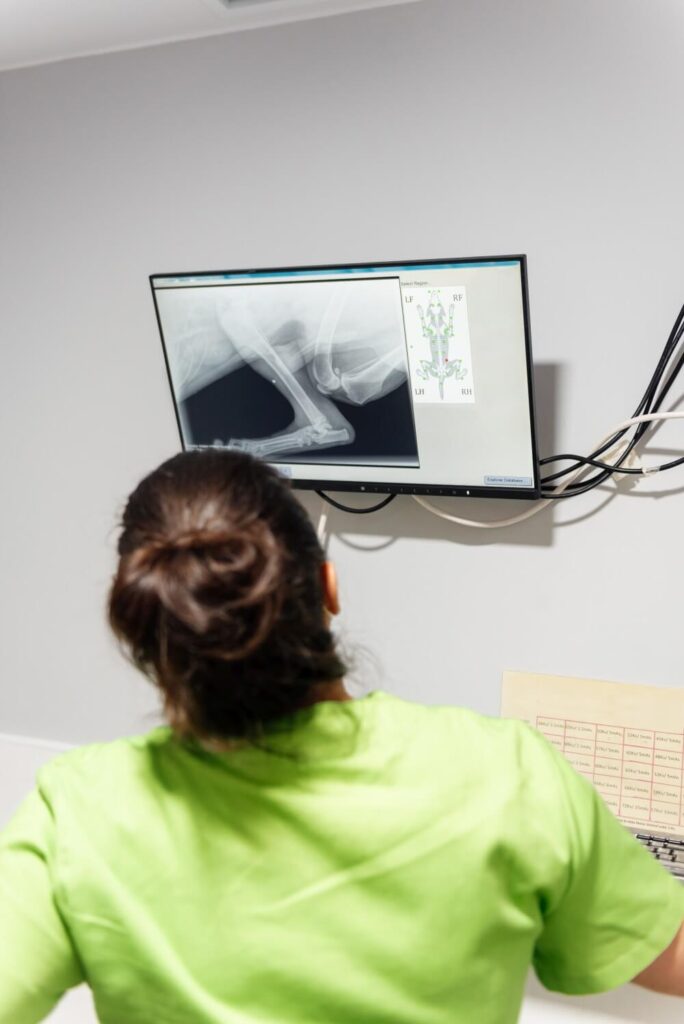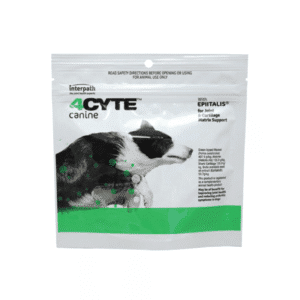Translated into plain English, the term ‘’arthritis’’ simply means joint inflammation. Dog arthritis is used to describe a variety of painful conditions that can develop in any joint in canines of any age and are accompanied by pain, swelling and stiffness. Arthritis occurs in both dogs and cats, but it is more common in dogs.
HOW ARTHRITIS DEVELOPS
In a normal dog, each joint is covered by cartilage that acts as a buffer or cushion between two bony surfaces. If the cartilage is damaged, an unleashed cascade of events leads to the rubbing of the two bony surfaces, inflammation, and eventually arthritis. In a nutshell, arthritis in dogs is the result of chronic, low-grade irritation and inflammation. The cartilage destruction can be caused by joint instability, ligament injury, trauma, degenerative changes, infections (bacterial or fungal arthritis), metabolic disturbances, or as a result of immune-mediated conditions. Most arthritis cases are simply due to aging. The most common type of acquired arthritis in dogs, osteoarthritis, is caused by joint or ligament injury.

TYPES OF ARTHRITIS IN DOGS
Osteoarthritis
Arthritis, osteoarthritis, or degenerative joint disease (DJD) affects about one out of five dogs during their lifetime. Large-breed dogs are affected more often than smaller breeds, and the disease usually develops as a dog grows older. DJD is progressive, and the damage that it causes is irreversible.
DJD occurs because the joint cartilage is unable to either maintain a healthy state or repair itself after damage. This fault in joint cartilage may occur because of abnormal physical force exerted on a normal joint or because of normal force on an abnormal joint. It may also occur seemingly for no reason.
Immune mediated arthritis
Also known as rheumatoid arthritis, this autoimmune condition, while common in humans, is relatively rare in dogs. It occurs mainly in the foot (carpal and tarsal) joints in toy or small breeds from about one to eight years old. Many dog parents think that their dogs are rheumatic or have rheumatism when, in fact, what they have is degenerative joint disease (DJD).
Rheumatoid dogs are uncomfortable, may have a fever, and may be reluctant to eat. In the early stages of rheumatoid arthritis, there may be enlargement of the lymph nodes.
More common than rheumatoid arthritis in dogs is a form of non-deforming autoimmune arthritis, usually seen in purebreds. This condition causes intermittent cycles of fever, lethargy, and lameness involving more than one joint.
Septic arthritis
Infectious diseases can produce arthritis. Bacteria can enter the joint space through penetrating wounds or from local infections, but they can also enter from distant infections when bacteria are carried to one or more joints through the blood. Bacterial infections on the skin or those occurring in the mouth, the heart valves, the kidneys, or even the bladder can result in bacterial arthritis. Borrelia burgdoferi, the tick-borne organism that causes Lyme disease and other tick-borne disease organisms, such as Rickettsia and Ehrlichia, can also travel to joint cavities via the bloodstream, as can the sandfly-transmitted organism that causes leishmaniasis.
Fungal arthritis may occur as a rare complication of a systemic fungal infection.
Polyarthritis
This disorder involves inflammation affecting multiple joints at once. It is an increasingly diagnosed condition. It can be triggered by hypersensitivity to a variety of drugs, including the antibiotic trimethoprim sulfa. As well as joint inflammation, affected dogs may also have fever, skin rashes, and swollen lymph nodes. The disorder may spontaneously disappear when the drug is discontinued.
SYMPTOMS OF ARTHRITIS IN DOGS
The first sign of arthritis in dogs is often a change in gait. Joint pain is the dull, aching type, and even if the dog is experiencing severe pain, they often won’t vocalize or cry. However, some dogs will lick or bite the painful area. Generally, arthritic dogs show several signs, such as:
- Difficulty getting up and down
- Walking stiffly
- Lameness in one or more legs
- Crepitus (a creaking or grating sound) in the joint when in motion
- Reluctance to go up and down stairs
- Reluctance to jump (onto or off furniture or into or out of a vehicle)
- Stiff, swollen, or sore joints
- Reluctance to be touched on some parts of the body
- Loss of stamina
- Unexpected aggression towards other dogs or humans
- Decreased appetite
- Loss of muscle mass in the affected limbs

DIAGNOSING ARTHRITIS IN DOGS
A vet will flex, extend, and rotate joints to access their range of motion and the severity of any pain. The vet may flex the affected joint and listen for signs of crepitus – a dry, grating sound from within the joint that indicates that the joint cartilage has worn away.
X-rays may show a narrowing of the joint space, new bone formation, calcium deposits in the joint cavity, or other pathological changes. The degree of change gives the vet a good idea of how advanced the arthritis has become.
Arthroscopy to view directly inside the affected joint and analysis of the joint fluid may also be undertaken.
Rheumatoid and non-deforming arthritis in dogs are hard to diagnose. Blood tests that reveal an elevated level of a substance called rheumatoid factor may help the vet make the diagnosis, but they are not conclusive.
A diagnosis of bacterial arthritis, overwhelmingly the most common form of infectious arthritis, is made by analyzing and culturing fluid withdrawn from the joints.

HOW TO PREVENT ARTHRITIS IN DOGS
The most effective way of preventing arthritis is to allow young dogs to grow slowly and maintain a lean body condition throughout their growth and into adulthood by using a species-appropriate and nutritionally balanced diet and providing regular exercise. With that said, the odds of preventing or at least delaying the signs of dog arthritis are excellent.
Genetic abnormalities, injuries, and geriatric changes cannot always be predicted. Therefore, even the best efforts may not be enough to ward off arthritis, especially in older dogs.
DOGS WITH ARTHRITIS TREATMENT
Effective arthritis management is usually multimodal and requires a combination of medication and complementary approaches, such as physiotherapy, diet, and weight management. Common general treatment options include:
- Prescription pain medications – the cornerstone of arthritic pain management are the non-steroidal anti-inflammatory drugs (NSAIDs) such as carprofen, deracoxib, firocoxib, and meloxicam. In more severe cases, the pain is managed with adjunctive pain medications such as tramadol or gabapentin.
- Possible use of nutritional joint supplements to help replenish cartilage (glucosamine, chondroitin sulphate, hyaluronic acid, and pentosan polysulphate).
- Weight-loss regimen if necessary, since obesity aggravates the symptoms; the goals are to decrease the load on the joints and increase the range of motion. It is proven that arthritis has worse clinical manifestations and triggers more complications in unfit and overweight dogs.
- Special diet – with high amounts of antioxidant rich foods (phytoplankton, astaxanthin, turmeric, wild berries, and herbs such as oregano, basil, cinnamon, parsley, cumin, and ginger).
- Physical therapy and working with a canine physical therapist (swimming pool, stretching and strengthening exercises, underwater treadmill, chiropractic care, cold laser, and electromagnetic stimulation).
- A low-stress environment, plenty of affection, and supportive care can help improve any dog’s or cat’s quality of life.

Injections for dogs with arthritis
Zydax® – unlike the commonly used NSAIDs, which address only the symptoms, Zydax® slows down the progression of arthritis in dogs while also relieving the associated pain and inflammation. The active substance, glucuronoxylan sulfate sodium (or pentosan polysufate sodiuum), is classified as a DMOAD (disease-modifying osteoarthritis drug). The treatment usually includes four injections given one week apart, repeated every 6 to 12 months.
Cartrophen Vet® – also classified as DMOAD, the active substance in this medication is also pentosan polysulfate sodium. Cartrophen Vet® acts by promoting joint health and delaying the onset of arthritis triggered complications. Over 80% of dogs with arthritis show significant improvement after treatment.
Natural remedies for arthritis in dogs
Fish oil – marine fish oil is particularly rich in natural and anti-inflammatory essential fatty acids (EFAs), particularly two substances known as EPA and DHA. Therefore, adding fish oil to your dog’s diet reduces joint inflammation and helps alleviate pain.
Glucosamine – a natural compound found in cartilage, is the most commonly used natural remedy for dogs with arthritis. It has been shown that the use of glucosamine helps with all forms of arthritis including the rheumatoid type.
Green lipped mussels – native to New Zealand, these bivalve mollusks are packed with glycosaminoglycans (GAGs). GAGs not only alleviate the symptoms of arthritis, but they also delay its onset and, if used early on, can even help to prevent its development.
Turmeric paste – more than 6,000 studies claim that turmeric paste alleviates the symptoms associated with arthritis in dogs. As a flowering plant of the ginger family, turmeric has potent anti-inflammatory and antioxidant properties. You can choose between the many commercially available turmeric pastes or prepare one from scratch at home.
Physiotherapy and holistic therapies
Physiotherapy, chiropractic care, hydrotherapy, acupuncture, electromagnetic stimulation, and cold laser treatments are all beneficial for dogs with arthritis.
Perhaps hydrotherapy (swimming and using the underwater treadmill) is the most efficient form of physiotherapy for dogs with arthritis. This is because hydrotherapy tones the muscles while supporting the joints.
Dog joint supplements
There are a number of joint supplements on the market in Australia which are available over the counter without a presciption. In our experience, and from customer feedback, the most popular dog arthritis supplements at the time of writing are Antinol Rapid and 4CYTE.
Antinol® Rapid – is an all-natural dog joint supplement made of several blended and sustainably sourced marine oils. This patented recipe comes in the form of easily digestible soft gel capsules.
4cyte® – specifically designed to repair damaged joints, 4cyte® stimulates cartilage production and suppresses the inflammatory chemicals responsible for joint degeneration. The active ingredients is Epiitalis, a patented plant extract. Recommended by vets, this product usually causes significant improvement in your dog’s joint health in just 7 to 14 days.
Glyde® – this revolutionary joint supplement contains clinically proven ingredients such as green-lipped mussels, glucosamine, and chondroitin. With proven levels of nutraceuticals, this product promotes joint health and normal cartilage repair. Plus, it is available over-the-counter.
Glyde mobility chews are popular because they are a chewable dog arthritis treat rather than a liquid or powder, as most other products are.
Sasha’s Blend® – containing natural marine concentrates, this powder is suitable for long-term use in dogs with arthritis. Sasha’s Blend® has two main goals: maintaining healthy joint function and promoting mobility. The powder is highly palatable and easy to use.
Rose Hip Vital® – this plant-based and fruit-flavored powder not only promotes joint health but also boosts your dog’s immune system. It is made of wild rosehips (berry-like fruits of the apple family). Rosehips protect your dog’s hips by breaking up the inflammatory cycle that causes degeneration.
HOW TO HELP A DOG WITH ARTHRITIS AT HOME?
As a responsible dog parent, there are several steps you can follow to improve your arthritic dog’s comfort and mobility:
- Purchase soft, heavy-padded bedding or an orthopaedic bed with built-in magnets.
- Use raised food and water dishes (preferably at elbow height).
- Keep food and water bowls at several easily accessible points around the house.
- Install a ramp for entering and leaving the vehicle.
- Ensure all surfaces are non-skid.
- Massage your dog and apply warm compresses.
- Adhere to the prescribed feeding, exercise, and medication recommendations.
THE PROGNOSIS FOR DOGS WITH ARTHRITIS
Once signs of arthritis show, the condition’s progression can be slowed down but not reversed. Most dogs respond well to treatment and live comfortably, but they will need to be on medications for the rest of their lives. Every dog requires a specific, tailored treatment plan, which needs to be discussed in detail with your vet.
WHEN TO EUTHANIZE A DOG WITH ARTHRITIS
Dog euthanasia should be considered when the associated pain becomes too severe to be sufficiently controlled medically, and there is a significant lack of mobility. There is no universally acceptable time; each case should be individually evaluated.
FAQ
The most frequent questions and answers about arthritis in dogs.
The first sign of arthritis is a reduced ability to carry out normal physical activities. An affected dog may not be as agile when exercising, for example, and may not bound up stairs as they used to. They may step into a car rather than leap into it. With time, arthritis causes obvious stiffness or lameness after robust or prolonged physical activity and then after shorter periods of activity. As the degeneration progresses, there may be stiffness or lameness even at rest.
Vets test for arthritis through physical examination; they pay attention to signs of pain and discomfort upon touch and evaluate the joint for extension and flexion ranges. Then they perform x-rays to confirm the diagnosis. Sometimes they can even order some blood tests – the goal is to rule out certain conditions associated with arthritis.
Yes. Low-impact exercises such as walking and swimming are beneficial for dogs with arthritis. However, during walks, the dog must be on a leash (that way you will be able to control the pace).
Many pet owners make the mistake of severely restricting their arthritic pet’s exercise. Unfortunately, this can lead to muscle wastage. Without sufficient muscle to support the skeletal system, joint pain in thinner legs is then exacerbated.
Most arthritis pain relief for dogs is only available via prescription. Once your vet has examined your pet and confirmed they have arthritis, repeat prescriptions are usually available over the counter, with the occasional in-person checkup.
However, there are a range of neutraceuticals that are available over the counter without a prescription, such as Antinol Rapid, 4CYTE, Glyde, Sashas Blend and Rose Hip Vital.
Vets usually prescribe non-steroidal anti-inflammatory drugs (NSAIDs). The most commonly prescribed NSAIDs are carprofen (Rimadyl, Novox), deracoxib (Deramax), firocoxib (Previcox), and meloxicam (Metacam).
No, unless instructed by your veterinarian, using some human medications for dogs can have life-threatening consequences for your pet.
Severe cases of arthritis in dogs may require more powerful or additional pain medications, such as gabapentin or tramadol. Their use should be extensively discussed with your trusted vet.
Yes, although it is more common in older dogs, puppies can also develop arthritis. This is particularly the case if your puppy has poor skeletal conformation.
Generally speaking, arthritis is a disease associated with old age. However, certain types of arthritis can develop in puppies as young as 4 to 8 months of age.
Arthritis does not shorten the dog’s lifespan. However, it does decrease the quality of life (because of the associated pain and impaired mobility). Nevertheless, with proper nutrition, supplementation, exercise, and pain management, dogs with arthritis can live long lives.
Sadly, the answer is no. Once arthritic changes develop, they cannot be reversed. However, their progress can be slowed down. At that point, the treatment has two goals: preventing pain and controlling further damage.
Yes. Massage improves circulation, promotes relaxation, and increases flexibility and mobility, which ultimately leads to relieved pain and reduced discomfort. The massage should be performed carefully without putting direct pressure on the already sore joints.
Yes. Acupuncture and some other holistic therapies may certainly make some dogs with arthritis more comfortable. The exact reason for this beneficial effect, however, remains elusive.
Arthritis is a joint inflammation that dogs usually get as they age due to natural wear and tear of the two bone surfaces making up the joint. Hip dysplasia is an abnormality most dogs are born with. Over time, dogs with hip dysplasia will inevitably develop arthritis in their abnormally formed hip joints. On the other hand, dogs with arthritis cannot develop hip dysplasia over time.
Dogs with arthritis are often euthanized when the associated pain becomes too severe to be sufficiently controlled medically and there is a significant lack of mobility. There is no universally acceptable time; each case should be individually evaluated.
REFERENCES
- BruceBlaus, CC BY-SA 4.0, via Wikimedia Commons
- Michael in A2, CC BY 2.0, via Wikimedia Commons







